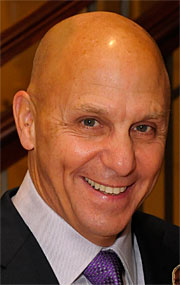- Number 348 |
- October 17, 2011
Lee fills the Matter in Extreme Conditions gap at SLAC

Richard “Dick” Lee
When Richard “Dick” Lee arrived at SLAC National Accelerator Laboratory last month to assume his duties heading up the Science, Research and Development Division of the Linac Coherent Light Source, he felt right at home.
Lee, who moved to SLAC from Lawrence Livermore National Lab, jokes that he has spent more time at SLAC over the last few years than he has at Lawrence Livermore. It all dates back to a 1999 talk he gave at SLAC in which he pointed out that a free-electron X-ray laser “would be a really swift thing” for studying warm dense matter, he says.
“Once they determined I wasn’t completely crazy, they included it in the LCLS proposals because it was unique and simply can’t be done anywhere else,” he says. “I’ve become ever more involved in getting that form of research funded at SLAC ever since.”
Warm dense matter hasn’t always been his passion. His focus was quite a bit hotter in the early years of his career. After doing undergraduate work at Johns Hopkins University and receiving his physics Ph.D. in 1970 from the University of Florida, he moved to Imperial College, London, where he developed new techniques – now widely used – to analyze the radiative properties of hot dense matter plasmas. Translation: Using ever larger lasers, he made ever hotter and denser plasmas to help study the physical processes of stars.
When physics funding in the UK evaporated in 1984, Lee moved to Lawrence Livermore, where he ultimately headed up high-energy laser experimentation. Starting in the mid-1990s, his focus began to shift to warm dense matter – the transitional phase between cold material and hot plasma, which now is sparking scientific activity worldwide.
As LCLS moved forward, Lee helped formulate plans for its initial experiments. But when the funding came through for the LCLS end station instruments, only five of the six proposed instruments were funded by the Department of Energy through its Basic Energy Sciences group. What was missing? The Matter in Extreme Conditions, or MEC, instrument, which covers research in the field of high energy density science.
“An infinite number of workshops later, we eventually got the money through fusion energy sciences in the DOE’s Office of Science,” he says. “That $20 million actually came from economic stimulus funds, so we’re glad for that.”
When it is commissioned next spring, the MEC instrument will be able to observe matter at temperatures exceeding 100,000 Kelvin and at pressures 5 million times that of Earth’s atmosphere at sea level.
While Lee obviously is delighted to be at SLAC for MEC’s debut, his new job – which was performed on an interim basis by LCLS deputy director Uwe Bergmann – makes him responsible for overseeing all of the instrument scientists and ongoing research and development of the beamlines themselves.
“The outcome I’m working toward is to get a coherent Science, Research and Development effort which continues the first experiments, the benchmark experiments, and the proofs of principle in all the important areas,” he says. “In the end, the idea is to form the nucleation sites for centers of excellence of various types in areas that are unique to the fourth-generation light source.”
Submitted by DOE's SLAC National Accelerator Laboratory
